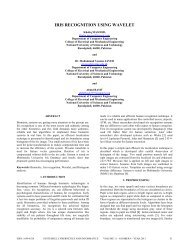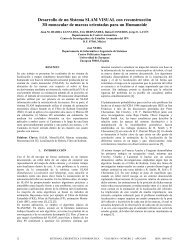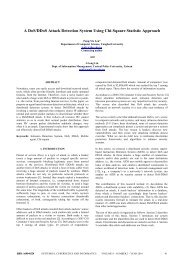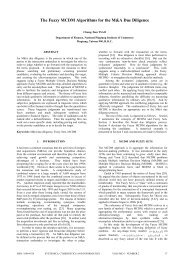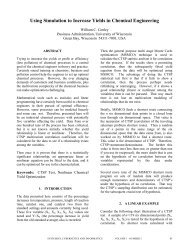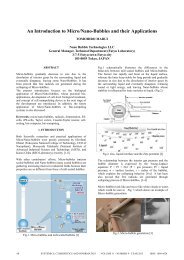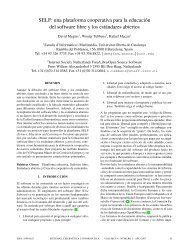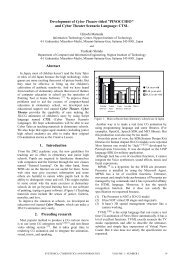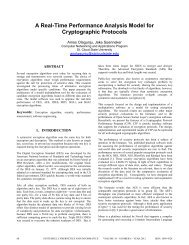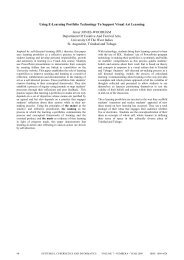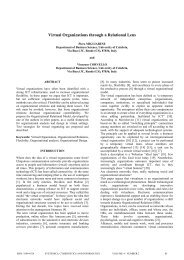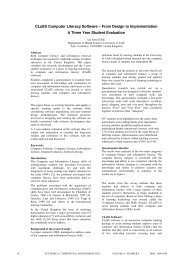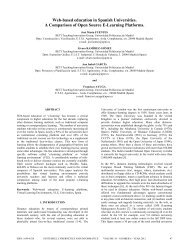The All-fiber MZI Structure for Optical DPSK Demodulation and ...
The All-fiber MZI Structure for Optical DPSK Demodulation and ...
The All-fiber MZI Structure for Optical DPSK Demodulation and ...
Create successful ePaper yourself
Turn your PDF publications into a flip-book with our unique Google optimized e-Paper software.
<strong>The</strong> <strong>All</strong>-<strong>fiber</strong> <strong>MZI</strong> <strong>Structure</strong> <strong>for</strong> <strong>Optical</strong> <strong>DPSK</strong> <strong>Demodulation</strong> <strong>and</strong> <strong>Optical</strong> PSBT<br />
Encoding<br />
Guillaume Ducournau, Olivier Latry <strong>and</strong> Mohamed Ketata<br />
LEMI, Laboratoire Electronique Microtechnologie et Instrumentation<br />
IUT-LEMI 76821 Mont Saint Aignan, France<br />
guillaume.ducournau@univ-rouen.fr<br />
ABSTRACT<br />
Since the beginning of optical telecommunications, the most<br />
simple modulation <strong>for</strong>mat has been employed in optical links.<br />
This <strong>for</strong>mat is called OOK (On Off Keying). With the increases<br />
in bit rates, number of optical channels in Dense Wavelength<br />
Division Multiplexing (DWDM) configuration, <strong>and</strong> the<br />
augmentation of power in each channel, new modulation<br />
<strong>for</strong>mats have been studied in the last years. Today, in order to<br />
increase the quality of optical links, tendency is to modify the<br />
modulation scheme used to encode in<strong>for</strong>mation in light signals.<br />
Particularly, the Differential Phase Shift Keying (<strong>DPSK</strong>)<br />
<strong>for</strong>mat presents an increased tolerance to non-linear effects in<br />
optical <strong>fiber</strong>s, justifying the interest <strong>for</strong> using this <strong>for</strong>mat in<br />
optical communications links.<br />
In the past two years, some studies investigated the possibilities<br />
to transmit 40 Gbps data rates on the deployed 10 Gbps links.<br />
An interesting solution consists in using the Phase Shaped<br />
Binary Transmission (PSBT) modulation <strong>for</strong>mat. With this<br />
technique, the system upgrade costs from 10 Gbps to 40 Gbps<br />
are reduced, justifying the use of PSBT.<br />
In this paper, we present two applications of Mach-Zehnder<br />
Inteferometers (<strong>MZI</strong>s), used in optical communication links.<br />
We first review the principles of the Differential Phase Shift<br />
Keying (<strong>DPSK</strong>), a phase modulation scheme, <strong>and</strong> its interest in<br />
optical communications. After that, we also focus on a recently<br />
introduced modulation <strong>for</strong>mat: the all-optical Phase Shaped<br />
Binary Transmission (PSBT).<br />
Keywords: <strong>Optical</strong> Communications, Modulation <strong>for</strong>mats,<br />
<strong>DPSK</strong>, PSBT, Mach-Zehnder Interferometer (<strong>MZI</strong>).<br />
1. INTRODUCTION<br />
Today, most of the optical telecommunication links use the<br />
well known modulation <strong>for</strong>mat called OOK (On Off Keying).<br />
Due to the increases in bit rates, power <strong>and</strong> number of DWDM<br />
channels, the OOK <strong>for</strong>mat reaches its limits <strong>for</strong> optical<br />
communications. Various modulation schemes have already<br />
been used in the electrical domain during last decade, but have<br />
not been applied in optics. Recently the use of new modulation<br />
<strong>for</strong>mats in optical communications has been considered <strong>and</strong><br />
compared <strong>for</strong> increasing the tolerance of the optical link to<br />
impairments such as chromatic dispersion, PMD or nonlinearity<br />
(Kerr Effect) [1-3].<br />
Among the various modulation <strong>for</strong>mats, we present here the<br />
Differential Phase Shift Keying (<strong>DPSK</strong>) scheme <strong>and</strong> the Phase<br />
Shaped Binary Transmission (PSBT). <strong>DPSK</strong> presents a better<br />
robustness to optical non-linearities than the classical OOK,<br />
particularly <strong>for</strong> the Cross Phase Modulation (XPM) in DWDM<br />
systems [1]. It has also been shown that <strong>DPSK</strong> <strong>for</strong>mat has<br />
better per<strong>for</strong>mances due to PMD degradations than the classical<br />
OOK [2]. <strong>The</strong> disadvantage of the <strong>DPSK</strong> is that a direct<br />
detection (DD) at the end of the optical link is not possible,<br />
since <strong>DPSK</strong> is a phase modulation. An interferometric<br />
demodulation stage must be inserted in front of the photodetection.<br />
This stage is an "Add <strong>and</strong> Delay" structure, which is<br />
composed by a <strong>MZI</strong>. In this structure, one arm presents an<br />
optical delay line equal to the bit duration. This <strong>MZI</strong> converts<br />
an optical <strong>DPSK</strong> to an intensity-modulated (IM) signal,<br />
followed by a DD.<br />
<strong>The</strong> PSBT <strong>for</strong>mat is encoded from a <strong>DPSK</strong>: first a <strong>DPSK</strong><br />
signal is generated <strong>and</strong> after that a <strong>MZI</strong> structure converts the<br />
<strong>DPSK</strong> to an intensity-modulated signal: the PSBT. <strong>MZI</strong><br />
characteristics <strong>for</strong> the two applications are slightly different, as<br />
we will see in the next sections.<br />
<strong>The</strong> paper is organised as follows: we first describe the<br />
principles of the <strong>DPSK</strong> <strong>and</strong> PSBT modulation schemes. After<br />
that, the <strong>MZI</strong> structure is detailed (section 4). <strong>The</strong> section 5<br />
focuses on experimental aspects <strong>for</strong> <strong>MZI</strong> characterization <strong>and</strong><br />
section 6 deals with the evaluation of the required<br />
per<strong>for</strong>mances <strong>for</strong> a <strong>MZI</strong> used as a <strong>DPSK</strong> demodulator. In<br />
section 7, a system implementation of an all-<strong>fiber</strong> <strong>MZI</strong> in a 43<br />
Gbps optical link is presented, <strong>and</strong> the some of the<br />
characteristics required <strong>for</strong> <strong>MZI</strong> used <strong>for</strong> PSBT encoding.<br />
2. PRINCIPLES OF <strong>DPSK</strong> MODULATION SCHEME<br />
Modulation<br />
In the paper, T b denotes the time duration of one bit, <strong>and</strong> t is the<br />
time. Moreover, we depicted here <strong>for</strong> convenience the case of<br />
NRZ (Non Return Zero) signals. For further in<strong>for</strong>mation about<br />
modulations <strong>for</strong>mats, see [3]. <strong>The</strong> well-known OOK <strong>for</strong>mat is a<br />
simple binary modulation of light: a “1” is represented by<br />
presence of optical signal, <strong>and</strong> “0” by no signal. This is not the<br />
case <strong>for</strong> <strong>DPSK</strong>, where optical signal is always present in the<br />
<strong>fiber</strong>. <strong>The</strong> in<strong>for</strong>mation is differentially encoded in the phase of<br />
the light: a precode c(k) is produced with the message m(k)<br />
according to the following rule :<br />
c ( k)<br />
= m(<br />
k)<br />
⊕ c(<br />
k −1)<br />
where k is the integer part of t/T b .<br />
⊕ represents the xor logic operation.<br />
<strong>The</strong> binary sequence c(k) drives a phase modulator, where a π<br />
phase shift is applied when c(k) = 1, <strong>and</strong> no phase shift if c(k) =<br />
0. To summarize this, we can write the <strong>for</strong>m of electrical fields<br />
in case of OOK <strong>and</strong> <strong>DPSK</strong>:<br />
(1)<br />
78 SYSTEMICS, CYBERNETICS AND INFORMATICS VOLUME 4 - NUMBER 4<br />
ISSN: 1690-4524
v(t)<br />
E<br />
E OOK<br />
<strong>DPSK</strong><br />
= m k).<br />
E 0<br />
.cos( ω . t)<br />
(<br />
0<br />
= E0.cos(<br />
ω0.<br />
t + c(<br />
k).<br />
π )<br />
<br />
∆ϕ<br />
( k )<br />
<strong>The</strong> binary in<strong>for</strong>mation (data) is carried by amplitude in the<br />
OOK modulation scheme, <strong>and</strong> by phase with <strong>DPSK</strong>.<br />
Wave<strong>for</strong>ms of the fields are represented in Figure 1. CW st<strong>and</strong>s<br />
<strong>for</strong> Continuous Wave, <strong>and</strong> represents the optical carrier.<br />
(2)<br />
(3)<br />
NRZ-OOK<br />
MZM<br />
Pulse<br />
carving<br />
RZ<br />
RZ 50 %<br />
NRZ<br />
RZ 33<br />
RZ<br />
RZ 66<br />
MZM<br />
transmission<br />
RZ 33 %<br />
RZ 66 %<br />
Eye<br />
diagrams<br />
V π<br />
0 2.V π<br />
Drive voltage<br />
v(t)<br />
Data<br />
MZM<br />
CW laser<br />
Constant-intensity<br />
<strong>for</strong>mat<br />
MZM<br />
<strong>DPSK</strong> eye diagram<br />
V π<br />
Figure 1. Wave<strong>for</strong>ms of electrical fields, <strong>and</strong> principle of<br />
<strong>DPSK</strong> demodulation.<br />
<strong>Demodulation</strong><br />
In order to recover the binary in<strong>for</strong>mation (message m(k))<br />
carried by OOK signal, a simple photo-diode can be used, this<br />
is the Direct Detection (DD). This is not the case <strong>for</strong> <strong>DPSK</strong>,<br />
where binary “1” <strong>and</strong> “0” have the same optical powers. A<br />
photo-diode can’t differentiate the two logic levels, <strong>and</strong> a<br />
demodulation stage is needed, to trans<strong>for</strong>m the phase<br />
modulated to an intensity modulated signal, followed by DD.<br />
<strong>The</strong> demodulation operation consists in a summation of the<br />
<strong>DPSK</strong> signal <strong>and</strong> the same delayed by the bit-duration T b , as<br />
indicated in Figure 1 <strong>for</strong> <strong>DPSK</strong>(t-T b ) <strong>and</strong> Sum signals. This<br />
demodulation stage is the <strong>MZI</strong>, <strong>and</strong> operation will be depicted<br />
in part 3. Here we note that when demodulating a <strong>DPSK</strong> signal,<br />
the first binary value is arbitrary, <strong>and</strong> an initialisation sequence<br />
will be necessary <strong>for</strong> transmission.<br />
<strong>DPSK</strong> Transmitter<br />
First of all, NRZ-OOK is classically obtained with a Mach-<br />
Zehnder Modulator (MZM) biased at half power of the<br />
transmission curve <strong>and</strong> driven with a Vπ amplitude signal [4].<br />
RZ <strong>for</strong>mats are then obtained with the pulse carving<br />
summarized in Figure 2. For <strong>DPSK</strong> signal generation, the<br />
MZM is driven in a push-pull configuration <strong>and</strong> biased at the<br />
minimum transmission curve, as presented in [4]. Finally,<br />
insets of the Figure 2 shows the eye diagrams obtained with<br />
these various modulation <strong>for</strong>mats.<br />
Data<br />
Figure 2. OOK <strong>and</strong> <strong>DPSK</strong> transmitters <strong>and</strong> pulse Carving <strong>for</strong><br />
RZ codes generation.<br />
As the <strong>DPSK</strong> <strong>for</strong>mat is a constant-intensity <strong>for</strong>mat, the non<br />
linear index modulation (Kerr effect) is reduced, resulting as a<br />
better robustness to non linear effects occurring during the<br />
propagation in optical <strong>fiber</strong>s.<br />
3. PRINCIPLES OF THE PSBT MODULATION<br />
SCHEME<br />
<strong>The</strong> second modulation <strong>for</strong>mat considered here is the “Phase<br />
Shaped Binary Transmissions”, optically encoded. Electrical<br />
PSBT has been proposed <strong>for</strong> the first time in [5]. It consists in<br />
driving Mach Zehnder Modulators (MZM) with electrical NRZ<br />
signals filtered by an appropriate Bessel filter. This ensures a<br />
superimposed phase modulated signal in addition to the<br />
conventional amplitude signal shape. This amplitude/phase<br />
profile leads to an increased robustness towards group velocity<br />
dispersion (GVD) in optical <strong>fiber</strong>s. Electrical PSBT signal is<br />
also often denoted as duobinary signal due to the reduced-size<br />
spectrum obtained.<br />
Electrical PSBT has been theoretically demonstrated in [6] <strong>and</strong><br />
after that experimental work [7, 8] confirmed the superior<br />
chromatic dispersion tolerance of PSBT versus conventional<br />
ISSN: 1690-4524<br />
SYSTEMICS, CYBERNETICS AND INFORMATICS VOLUME 4 - NUMBER 4 79
NRZ signals. <strong>All</strong> optical solution <strong>for</strong> PSBT generation have<br />
been proposed in [9]. This solution has been experimentally<br />
demonstrated to ensure a higher tolerance to GVD than<br />
conventional NRZ, but less GVD robustness than electrical<br />
PSBT generation.<br />
<strong>The</strong> all optical PSBT solution presents a very attractive<br />
characteristic: one optical filter (Mach Zehnder Interferometer,<br />
<strong>MZI</strong>) is needed <strong>for</strong> all ITU channels, due to the fact that the<br />
<strong>MZI</strong> has a Free Spectral Range (FSR) equal to the ITU grid<br />
spacing. This WDM compliance is an advantage over electrical<br />
PSBT, which requires n Bessel filters <strong>for</strong> n channels encoding.<br />
<strong>All</strong>-optical PSBT is obtained with partial <strong>DPSK</strong> demodulation<br />
with <strong>MZI</strong> filter [9] <strong>and</strong> reported in Figure 3.<br />
Data<br />
CW laser<br />
V π<br />
MZM<br />
<strong>DPSK</strong> transmitter<br />
Data<br />
MZM<br />
<strong>MZI</strong> filter<br />
20 ps delay<br />
FSR = 50 GHz<br />
<strong>DPSK</strong> eye diagram<br />
Figure 3. PSBT transmitter.<br />
4. THE <strong>MZI</strong> STRUCTURE<br />
PSBT eye diagram<br />
(<strong>for</strong> 40 Gbps)<br />
We have seen that <strong>DPSK</strong> <strong>and</strong> PSBT can offer improved<br />
per<strong>for</strong>mances but an interferometric conversion is needed. As<br />
explained in section 2, the principle of <strong>DPSK</strong> demodulation is a<br />
time superposition of optical electric field <strong>and</strong> the same<br />
delayed by the bit duration (T b ). <strong>The</strong> optical circuit used <strong>for</strong><br />
realizing this operation is shown in Figure 4. A 3 dB optical<br />
coupler is used <strong>for</strong> separation of optical electric field between<br />
two arms. One arm has a superior <strong>fiber</strong> length ∆L <strong>for</strong> delaying<br />
optical signal by T b . <strong>The</strong>n a second 3 dB optical coupler<br />
combines the optical power at the end of the two arms.<br />
Figure 4. 4-Ports <strong>MZI</strong> structure.<br />
Without taking into account any polarization effects, a possible<br />
approach to describe the transfer function of the device is to<br />
use the transfer matrix theory [10]. In this theory, 2*2 matrices<br />
are used to represent trans<strong>for</strong>mation of fields:<br />
Figure 5. Two ports optical device.<br />
<strong>The</strong> relation between in <strong>and</strong> out ports of the passive device is<br />
written as (5):<br />
a<br />
<br />
a<br />
out,1<br />
out,2<br />
m11<br />
m <br />
a<br />
12<br />
=<br />
<br />
<br />
m21<br />
m22<br />
a<br />
<br />
M<br />
in,1<br />
in,2<br />
Optimal <strong>MZI</strong> device<br />
For an ideal 3 dB optical coupler (50/50 coupling ratios), the<br />
transfer matrix M 3dB is:<br />
1 1<br />
j<br />
M<br />
3 dB<br />
= <br />
(6)<br />
2 j 1<br />
Where j 2 = -1. In this coupler, 50% of power in each input port<br />
is coupled in the output ports. For a phase shifter device, the<br />
transfer matrix is:<br />
M<br />
∆ϕ<br />
j.<br />
∆<br />
e<br />
= <br />
0<br />
0<br />
<br />
<br />
= e<br />
<br />
<br />
<br />
<br />
j.<br />
∆<br />
e<br />
<br />
0<br />
ϕ1 ϕ<br />
j.<br />
∆ϕ<br />
2<br />
j.<br />
∆ϕ<br />
2<br />
e<br />
0<br />
<br />
1<br />
<br />
where: ∆ϕ = ∆ϕ 1 - ∆ϕ 2 , represents the phase imbalance<br />
between two arms, <strong>and</strong> ∆ϕ 1 , ∆ϕ 2 st<strong>and</strong> <strong>for</strong> the supplementary<br />
optical phases when electric fields travelled along the upper<br />
arm or in the other, respectively. Here, in the phase shifter of<br />
Figure 4, <strong>and</strong> ∆ϕ 1 <strong>and</strong> ∆ϕ 2 are:<br />
∆ϕ 1<br />
= β.(<br />
L + ∆L)<br />
<strong>and</strong> ∆ ϕ<br />
2<br />
= β. L<br />
where β is the propagation constant of the guided mode along<br />
the <strong>fiber</strong>. <strong>The</strong> supplementary length of <strong>fiber</strong> ∆L in the upper<br />
arm has to delay electrical field by the bit duration T b , so we<br />
can write:<br />
∆ ϕ = β∆L = ω.T b<br />
(9)<br />
where ω is the optical frequency.<br />
Typical bit rates are 10, 20 <strong>and</strong> 40 Gbps. For these three values,<br />
table 1 gives the supplementary length ∆L needed between two<br />
arms of <strong>MZI</strong> <strong>for</strong> <strong>DPSK</strong> demodulation. We use classical SMF<br />
28 <strong>fiber</strong> with following parameters:<br />
n core = 1.4675, n cladding = 1.46422, r core = 4.5 µm, r cladding = 62.5<br />
µm.<br />
Bit rate (Gbit/s), FSR (GHz) 10 20 40<br />
Bit duration Tb (ps) 100 50 25<br />
∆L (cm) 2,046 1,023 0,511<br />
Table 1. Values of supplementary length ∆L in one arm.<br />
With Eq. (6) <strong>and</strong> Eq. (7), the total transfer matrix of the <strong>MZI</strong><br />
device is:<br />
M<br />
M<br />
<strong>MZI</strong><br />
= M<br />
3 dB. M<br />
∆ϕ.<br />
M<br />
3dB<br />
e<br />
2<br />
<br />
<br />
j<br />
j∆ϕ<br />
j∆ϕ<br />
e −1<br />
j.<br />
( e + 1)<br />
( )<br />
<br />
j∆ϕ<br />
j ϕ<br />
. e + 1 1−<br />
e <br />
j∆ϕ<br />
2<br />
<strong>MZI</strong><br />
=<br />
∆<br />
For <strong>DPSK</strong> demodulation, the optical field is inserted in input<br />
port 1, <strong>and</strong> the second input port have no signal. <strong>The</strong> output<br />
fields amplitudes can be written as:<br />
(5)<br />
(7)<br />
(8)<br />
(10)<br />
80 SYSTEMICS, CYBERNETICS AND INFORMATICS VOLUME 4 - NUMBER 4<br />
ISSN: 1690-4524
a<br />
a<br />
<br />
a<br />
<br />
a<br />
out1<br />
out 2<br />
<br />
= M<br />
<br />
a<br />
. <br />
0<br />
out1 in1<br />
<strong>MZI</strong><br />
out 2<br />
j∆ϕ<br />
2<br />
e<br />
= .<br />
2<br />
j∆ϕ<br />
2<br />
e<br />
= . j<br />
2<br />
<br />
<br />
<br />
j∆ϕ<br />
( e −1.<br />
)<br />
a<br />
j∆ϕ<br />
.( e + 1 ).<br />
If an optical field modulated in <strong>DPSK</strong> <strong>for</strong>mat is injected in port<br />
In1, we have:<br />
<br />
<br />
a<br />
<br />
a<br />
<br />
<br />
<br />
a<br />
a<br />
<br />
out1<br />
out 2<br />
out1<br />
out 2<br />
j∆ϕ<br />
2<br />
e<br />
=<br />
2<br />
j∆ϕ<br />
2<br />
e<br />
= . j.<br />
2<br />
j∆ϕ<br />
2<br />
e<br />
=<br />
2<br />
j∆ϕ<br />
2<br />
e<br />
= . j<br />
2<br />
jωTb<br />
.( e − 1. )<br />
a<br />
jωTb<br />
( e + 1 ).<br />
a<br />
in1<br />
a<br />
<strong>DPSK</strong><br />
in1<br />
<strong>DPSK</strong><br />
( t)<br />
( t)<br />
.( a ( t −T<br />
) − a ( t)<br />
)<br />
<strong>DPSK</strong><br />
.( a ( t −T<br />
) + a ( t)<br />
)<br />
<strong>DPSK</strong><br />
b<br />
b<br />
<strong>DPSK</strong><br />
<strong>DPSK</strong><br />
In Eq. (13), we see that the port Out2 of <strong>MZI</strong> structure realizes<br />
the <strong>DPSK</strong> demodulation. <strong>The</strong> output field is equal to the sum of<br />
<strong>DPSK</strong> signal <strong>and</strong> the same, delayed by T b . <strong>The</strong> Out2 port is<br />
denoted as “constructive port”. <strong>The</strong> other out port is called<br />
“destructive port”. For evaluation of power transmission in the<br />
two output ports, the optical powers (P = K.a.a * , where * is the<br />
complex conjugate) of the device can be written as:<br />
jωTb<br />
− jωTb<br />
.( e −1)( e −1 ).<br />
1<br />
Pout<br />
1<br />
=<br />
Pin<br />
1<br />
4<br />
1 jωTb<br />
− jωTb<br />
Pout<br />
2<br />
= .( e + 1)( e + 1. ) Pin<br />
1<br />
4<br />
Pout<br />
1<br />
1<br />
( )<br />
T1<br />
= = . 1−<br />
cos(2. π.<br />
ν.<br />
Tb<br />
)<br />
Pin<br />
1<br />
2<br />
P 1<br />
<br />
out 2<br />
T2<br />
= = .( 1+<br />
cos(2. π.<br />
ν.<br />
Tb<br />
))<br />
<br />
Pin<br />
1<br />
2<br />
(11)<br />
(12)<br />
(13)<br />
(14)<br />
(15)<br />
where ω=2.π.ν, <strong>and</strong> ν is the optical frequency.<br />
<strong>The</strong>se two last expressions bring definition of four parameters<br />
<strong>for</strong> the <strong>MZI</strong>. First, the FSR (Free Spectral Range) is defined as<br />
the spectral period of transmission spectrum. <strong>The</strong> differential<br />
delay T b is then equal to 1/FSR. Three, the Insertion loss (IL)<br />
of <strong>MZI</strong> will be the absolute max value of transmission in dB<br />
scale, in each port. For an ideal <strong>MZI</strong>, the IL is 0 dB in two<br />
ports. Last, the isolation of <strong>MZI</strong> will be the gap between<br />
maximal <strong>and</strong> minimal transmission values of the spectrum, also<br />
in each port. Here, the minimal transmission is 0 (-∞ dB) <strong>and</strong><br />
the maximum is 1 (0 dB). <strong>The</strong> ideally isolation <strong>for</strong> the two<br />
ports is ∞. <strong>The</strong> power transmission in dB scale of the two<br />
output ports are represented in Figure 6. Frequency values are<br />
chosen from 193.25 THz to 193.55 THz, corresponding to the<br />
ITU channels 24 to 26.<br />
Non optimal <strong>MZI</strong><br />
<strong>The</strong> isolation of <strong>MZI</strong> device is a critical parameter <strong>for</strong> <strong>DPSK</strong><br />
demodulation because logical “0” are created by destructive<br />
interferences at an output port. If the contrast of interference is<br />
not optimal (equals to 1 ideally, corresponding to an infinite<br />
isolation), the demodulated “0” will contain optical power, then<br />
the OSNR (<strong>Optical</strong> Signal to Noise Ratio) will be reduced, <strong>and</strong><br />
the BER as well. <strong>The</strong>re are three sources which can affect the<br />
isolation value: non ideal couplers, an arm containing more<br />
optical losses than the other, <strong>and</strong> the <strong>MZI</strong> dependence to<br />
polarisation.<br />
-5<br />
Isolation<br />
-10<br />
Transmission (dB)<br />
Figure 6. Power transmission of ideal <strong>MZI</strong>. T b = 25 ps, FSR =<br />
40 GHz. Isolation = ∞. Solid curve: T 1 dB <strong>and</strong> dashed curve T 2<br />
dB.<br />
Transmission spectra of non-ideal <strong>MZI</strong>s<br />
<strong>The</strong> transmissions T1 <strong>and</strong> T2 <strong>for</strong> the two output take a different<br />
<strong>for</strong>m from Eq. (15). For an optical coupler with a 1 2 /b 1 2 coupling<br />
ratios, the transfer matrix can be written as Eq. (16) [10].<br />
Adding a loss in one of the two arms, the phase shifter’s matrix<br />
became Eq. (17):<br />
with a 2 1 + b 2 1 = 1.<br />
j.<br />
∆<br />
e<br />
M ' = <br />
∆ϕ<br />
0<br />
M coupler<br />
α.<br />
e<br />
a1<br />
=<br />
<br />
j.<br />
b<br />
0<br />
1<br />
<br />
<br />
= e<br />
<br />
j.<br />
b1<br />
<br />
<br />
a1<br />
<br />
. ∆<br />
e<br />
<br />
0<br />
ϕ1 j ϕ<br />
j.<br />
∆ϕ<br />
2<br />
j.<br />
∆ϕ<br />
2<br />
0 <br />
<br />
α<br />
<br />
where α takes places <strong>for</strong> the optical loss in the under arm.<br />
<strong>The</strong> total transfer matrix is calculated as previous, leading to:<br />
M '<br />
<strong>MZI</strong><br />
M '<br />
<strong>MZI</strong><br />
5<br />
0<br />
-15<br />
-20<br />
-25<br />
-30<br />
-35<br />
-40<br />
= e<br />
= e<br />
j∆ϕ<br />
2<br />
j∆ϕ<br />
2<br />
ITU 24<br />
a<br />
2<br />
<br />
j.<br />
b<br />
<br />
<br />
j<br />
2<br />
j∆<br />
j.<br />
b2<br />
e<br />
.<br />
<br />
a<br />
2 0<br />
ϕ<br />
0 a1<br />
<br />
.<br />
<br />
α j.<br />
b<br />
j.<br />
b1<br />
<br />
<br />
a1<br />
<br />
j∆ϕ<br />
j∆ϕ<br />
a −<br />
( + )<br />
( ) <br />
2.<br />
a1.<br />
e α.<br />
b2.<br />
b1<br />
j.<br />
a<br />
2.<br />
b1.<br />
e α.<br />
b2.<br />
a1<br />
j∆ϕ<br />
j∆ϕ<br />
. a1.<br />
b2<br />
. e + α.<br />
b1.<br />
a<br />
2<br />
α.<br />
a<br />
2.<br />
a1<br />
− b2<br />
. b1<br />
. e <br />
where the index i in a i <strong>and</strong> b i denotes the i th coupler of <strong>MZI</strong><br />
device. For an ideal <strong>MZI</strong>, we take a 1 , a 2 , b 1 <strong>and</strong> b 2 equal to<br />
1/ 2 , <strong>and</strong> α = 1. T1 <strong>and</strong> T2 become:<br />
2 2 2 2 2<br />
T'<br />
1<br />
= a1<br />
. a2<br />
+ b1<br />
. b2<br />
. α − 2. a1.<br />
a2.<br />
b1.<br />
b2.<br />
α.cos(2.<br />
π . ν.<br />
Tb<br />
)<br />
(19)<br />
2 2 2 2 2<br />
T<br />
'<br />
2<br />
= a1<br />
. b2<br />
+ b1<br />
. a2.<br />
α + 2. a1.<br />
a2.<br />
b1.<br />
b2.<br />
α.cos(2.<br />
π.<br />
ν.<br />
Tb<br />
)<br />
With Eq. (19) we can write the isolation value in each port:<br />
Isolation<br />
Isolation<br />
i,<br />
dB<br />
1, dB<br />
Ti<br />
= 10.log<br />
Ti<br />
'<br />
max<br />
'<br />
min<br />
<br />
a1.<br />
a<br />
= 10.log<br />
<br />
<br />
<br />
a1.<br />
a<br />
2<br />
<br />
a <br />
1.<br />
b2<br />
+ b1.<br />
a2.<br />
α<br />
Isolation = <br />
<br />
<br />
2, dB<br />
10.log<br />
<br />
<br />
<br />
a1.<br />
b2<br />
− b1.<br />
a2.<br />
α<br />
(20)<br />
<br />
<br />
<strong>The</strong> insertion loss of a non ideal <strong>MZI</strong> is not equal to 0 dB, <strong>and</strong><br />
will be different <strong>for</strong> the two output ports:<br />
IL<br />
IL<br />
FSR<br />
1, dB<br />
2, dB<br />
T1 dB<br />
193.25 193.3 193.35 193.4 193.45 193.5 193.55<br />
= 10.log<br />
= 10.log<br />
Frequency (THz)<br />
<br />
<br />
<br />
2<br />
2<br />
1<br />
2<br />
+ b <br />
1.<br />
b2.<br />
α<br />
<br />
− b1.<br />
b2.<br />
α <br />
<br />
( a . a + b . b . α )<br />
1<br />
( a . b + b . a . α ) 2<br />
1<br />
2<br />
2<br />
T2 dB<br />
ITU 25 ITU 26<br />
1<br />
1<br />
2<br />
2<br />
2<br />
(16)<br />
(17)<br />
(18)<br />
(21)<br />
ISSN: 1690-4524<br />
SYSTEMICS, CYBERNETICS AND INFORMATICS VOLUME 4 - NUMBER 4 81
On practical <strong>MZI</strong>s, IL i can be wavelength dependent. <strong>The</strong><br />
uni<strong>for</strong>mity is then defined as the maximum difference between<br />
IL i at different wavelengths. In Figure 7, we plot transmission<br />
<strong>for</strong> non-ideal couplers (coupling ratios a 1 2 /b 1 2 different from<br />
50/50), without optical losses in under arm. With Eq. (21), the<br />
IL is 0 dB. In Figure 8, we plot transmission <strong>for</strong> ideal couplers,<br />
with an under arm loss of 0.45 dB (α = 0.95). <strong>The</strong> IL equals to<br />
0.22 dB in two ports, <strong>and</strong> we can verify on the graph that<br />
maximal transmission is not 0 dB. <strong>The</strong> Figures 7 <strong>and</strong> 8 show<br />
that a default in coupling ratio (not exactly equal to 50/50), <strong>and</strong><br />
the presence of a loss in under arm affect the quality of<br />
interference: isolations values are degraded.<br />
0<br />
T1 dB<br />
T2 dB<br />
Isolation port 1 (dB)<br />
50<br />
45<br />
40<br />
35<br />
30<br />
25<br />
20<br />
15<br />
10<br />
5<br />
50 55 60 65 70<br />
Coupling ratio (%)<br />
Transmission (dB)<br />
-5<br />
-10<br />
-15<br />
-20<br />
-25<br />
-30<br />
-35<br />
-40<br />
ITU 24<br />
ITU 25 ITU 26<br />
193.25 193.3 193.35 193.4 193.45 193.5 193.55<br />
Frequency (THz)<br />
Figure 7. Power spectrum of a non-ideal <strong>MZI</strong>: the coupling<br />
ratio of optical couplers is 52/48. Here α = 1 (no losses in<br />
under arm). Isolation 1 = 27.96 dB, Isolation 2 = ∞. IL 1 = 0 dB.<br />
IL 2 ≈ 0 dB.<br />
0<br />
IL (dB)<br />
-5<br />
Transmission (dB)<br />
-10<br />
-15<br />
-20<br />
-25<br />
-30<br />
-35<br />
-40<br />
ITU 24<br />
T1 dB<br />
193.25 193.3 193.35 193.4 193.45 193.5 193.55<br />
Frequency (THz)<br />
T2 dB<br />
ITU 25 ITU 26<br />
Figure 8. Power spectrum of a non-ideal <strong>MZI</strong>: the coupling<br />
ratio of couplers is 50/50, <strong>and</strong> with an under arm loss of 0.45<br />
dB. Isolation 1 = Isolation 2 = 31.82 dB. IL = IL 1 = IL 2 = 0.22<br />
dB.<br />
In Figures 9 <strong>and</strong> 10, we plot the degradation of isolations<br />
versus evolution of coupling ratios a 1 2 <strong>and</strong> a 2 2 , <strong>and</strong> also with α.<br />
Figure 9. Evolution of isolation in port 1 versus coupling ratio<br />
a 1 2 = a 2 2 . Isolation in port 2 is infinite, due to α =1.<br />
If the two effects (coupling ratios different from 50/50 <strong>and</strong> loss<br />
in under arm) add themselves, the value of isolations are given<br />
by Eq. (20). With these expressions, we can say that isolation<br />
can’t be infinite at the same time <strong>for</strong> the two output ports.<br />
Moreover, isolations in two ports are not equal. This will be a<br />
source of BER degradation when using balanced photodetection,<br />
but it will not be studied here. For exemple, the<br />
transmission spectra of a <strong>MZI</strong> with two defaults is plotted in<br />
Figure 11.<br />
Isolation (dB)<br />
50<br />
45<br />
40<br />
35<br />
30<br />
25<br />
20<br />
Isolation 1 dB = Isolation 2 dB<br />
15<br />
0 0.5 1 1.5 2 2.5 3<br />
Loss in under arm (dB)<br />
Figure 10. Evolution of Isolation in two ports versus α (loss in<br />
under arm). <strong>The</strong> coupling ratios are 50/50.<br />
0<br />
IL 1 (dB)<br />
-5<br />
Transmission (dB)<br />
-10<br />
-15<br />
-20<br />
-25<br />
T1 dB<br />
T2 dB<br />
-30<br />
-35<br />
-40<br />
ITU 24<br />
ITU 25 ITU 26<br />
193.25 193.3 193.35 193.4 193.45 193.5 193.55<br />
Frequency (THz)<br />
Figure 11. Transmission spectra of <strong>MZI</strong> with two defaults:<br />
coupling ratios 55/45, <strong>and</strong> 0.45 dB under arm loss. Isolation 1 =<br />
18.04 dB, Isolation 2 = 31.82 dB. IL 1 = 0.198 dB, IL 2 = 0.265<br />
dB.<br />
82 SYSTEMICS, CYBERNETICS AND INFORMATICS VOLUME 4 - NUMBER 4<br />
ISSN: 1690-4524
We now focus on the port 2, which realizes <strong>DPSK</strong><br />
demodulation. In Figure 12 we plotted insertion loss surface in<br />
port 2 versus α dB <strong>and</strong> coupling ratio a 1 2 .<br />
Low IL<br />
Figure 12. Evolution of IL with coupling ratio a 1 2 <strong>and</strong> arm loss<br />
α dB.<br />
As can be seen, port 2 has no IL when arms are lossless <strong>and</strong><br />
with 50/50 coupling ratios. <strong>The</strong> Insertion loss increases with<br />
losses in under arm <strong>and</strong> with default in coupling ratios. We can<br />
conclude on study of IL <strong>and</strong> isolation by saying: Practical <strong>MZI</strong>s<br />
should have low ILs <strong>and</strong> high isolation in port 2, <strong>and</strong> this may<br />
be obtained by combining coupling ratios 50/50, <strong>and</strong> a low loss<br />
in under arm.<br />
Influence of polarisation<br />
We said that the <strong>MZI</strong> was polarisation sensitive: when light<br />
travels in two arms, polarisation is r<strong>and</strong>omly fluctuating. At the<br />
second optical coupler, it is highly probable that polarisations<br />
of fields in two arms will be different, <strong>and</strong> the interference will<br />
not be completely destructive. A few part of optical power will<br />
be transmitted <strong>and</strong> the isolation value will be degraded by this<br />
way. In order to reduce these isolations degradations, the<br />
lengths of the two arms has to be as small as possible, without<br />
any mechanical constrains, or as small as possible.<br />
<strong>MZI</strong> thermal drift<br />
If the interferometer is in a variable temperature (written as T<br />
in (23)) environment, two effects will induce a frequency shift<br />
on the interferometer transmission spectra: the thermo-optic<br />
effect <strong>and</strong> the thermal expansion effect. <strong>The</strong> thermo-optic<br />
effect modifies the value of the core index, resulting in a<br />
variation of the effective index δneff, thus inducing a variation<br />
of the propagation constant δβ. <strong>The</strong>rmal expansion effect<br />
implies a phase variation induced by the differential length<br />
variation δ(∆L). <strong>The</strong> variation of the differential phase between<br />
the two arms obtained by these two effects is finally given by<br />
(23).<br />
∆ϕ<br />
= β.<br />
∆L<br />
δ ( ∆ϕ)<br />
= δβ.<br />
∆L<br />
+ β.<br />
δ ( ∆L)<br />
(22)<br />
<br />
T . O.<br />
E.<br />
High IL<br />
T . E.<br />
E.<br />
2. π<br />
δ ( ∆ϕ)<br />
= . δneff<br />
. ∆L<br />
+ β.<br />
αt.<br />
∆L.<br />
δT<br />
(23)<br />
λ<br />
In (3), αt is the thermal expansion coefficient, equal to<br />
0.55*10-6 K -1 <strong>for</strong> the single mode <strong>fiber</strong> (SMF) 28. <strong>The</strong><br />
effective index variation due to a small thermal shift δT is<br />
δneff, <strong>and</strong> the wavelength is λ.<br />
<strong>The</strong> calculus of δn eff is obtained with the first order<br />
approximation δn core/cladding = χ t·n core/cladding·δT, <strong>and</strong> after that<br />
δn eff is calculated <strong>for</strong> the LP01 mode, where χ t is the thermooptic<br />
coefficient, evaluated at 8.6*10 -6 by [11].<br />
This thermal drift shows that <strong>MZI</strong> filters need to be<br />
temperature-stabilized when used as passive structures <strong>for</strong><br />
<strong>DPSK</strong> demodulation or PSBT optical encoding. Moreover,<br />
optical PSBT encoding needs the <strong>MZI</strong> to remain centered at its<br />
transmission peaks. <strong>The</strong>re<strong>for</strong>e, if a Mach-Zehnder<br />
interferometer is thermally insulated from exterior fluctuations,<br />
a second system is needed to maintain the transmission peaks<br />
on ITU channels (<strong>for</strong> the constructive port in both <strong>DPSK</strong> <strong>and</strong><br />
PSBT applications). This second adjustment is obtained by<br />
applying a supplementary phase shift in one arm, obtained by<br />
the heating of one arm of the interferometer.<br />
<strong>The</strong> implementation of this system must be without mechanical<br />
constraints to ensure a low sensitivity of the whole <strong>MZI</strong> device<br />
to polarization effects, usually quantified <strong>for</strong> optical filters as<br />
differential group delay) or PD-λ [12]. PD-λ = polarisation<br />
dependent wavelength: specification of the maximal frequency<br />
shift between all polarisation states at the input of the<br />
component. A second reason justifying the constraint-loss<br />
criteria <strong>for</strong> the heating system is that a large number of<br />
expansions/contractions due to the heating could break the<br />
interferometer arm.<br />
Description of the 49.5 GHz <strong>MZI</strong> Used in Section 7<br />
In order to test the all optical PSBT encoding a temperature<br />
stabilized <strong>MZI</strong> must be used. For this application, an accurate<br />
temperature stabilisation process has been developed <strong>and</strong><br />
consists of:<br />
a general regulation circuit which stabilises the temperature <strong>for</strong><br />
the whole <strong>MZI</strong> device. This regulation is per<strong>for</strong>med by<br />
packaging the <strong>MZI</strong> device in an aluminium box stabilized with<br />
Peltier elements, <strong>and</strong> after that a local heating system without<br />
mechanical constraints to adjust the centre of the <strong>MZI</strong> on a 50<br />
GHz frequency range.<br />
Figure 13 summarizes the stabilization process: when the<br />
exterior temperature (Text) fluctuates, the <strong>MZI</strong> peaks fluctuate<br />
from left to right with a 1.45 GHz/°C drift coefficient.<br />
In (b), the general <strong>MZI</strong> insulation reduces exterior temperature<br />
fluctuation on the <strong>MZI</strong>; the peaks present no more frequency<br />
shifts, but the peak frequencies do not correspond to the ITU<br />
frequencies.<br />
In (c), the local heating system produces the phase shift<br />
required in one of the <strong>MZI</strong> arms <strong>for</strong> the adjustment of the <strong>MZI</strong><br />
peaks on the ITU grid.<br />
Another important point of the thermal stabilisation pro-cess is<br />
the accuracy obtained when the general stabilisation of the <strong>MZI</strong><br />
is operating (Fig. 13 (b)). In Fig. 14, the evolution of the output<br />
power (<strong>for</strong> a constant wavelength) of the <strong>MZI</strong> is plotted versus<br />
time during the stabilisation process. At first (t ∈ [0;1500]<br />
seconds), the output optical power fluctuates with the<br />
fluctuation of the <strong>MZI</strong> package temperature as the <strong>MZI</strong> spectra<br />
shifts from left to right. After that, we can say that when<br />
stabilised (after around 2 hours <strong>and</strong> 20 minutes), the output<br />
power remains constant showing a good stabilisation accuracy<br />
of the whole <strong>MZI</strong> ((S) zone in Fig. 14).<br />
ISSN: 1690-4524<br />
SYSTEMICS, CYBERNETICS AND INFORMATICS VOLUME 4 - NUMBER 4 83
Finally, it is also necessary to point out that the <strong>fiber</strong><br />
temperature can not be measured in the system. Thus, it is the<br />
<strong>MZI</strong> package temperature which is represented in Fig. 14(a).<br />
Nevertheless, as the stability criteria of the <strong>MZI</strong> is the stability<br />
of output optical power at a constant wavelength, we can<br />
conclude with the Fig. 14(b) that the interferometer is well<br />
stabilised.<br />
Fig. 13. <strong>The</strong>rmal stabilization process: no stabilization (a),<br />
general regulation (b), <strong>and</strong> fine adjustment provided by the<br />
differential heating system (c). Text is the exterior temperature.<br />
<strong>The</strong> system is slow but is characterised by good stability over a<br />
long stabilisation time. A less than 0.1 °C accuracy has been<br />
obtained over many hours <strong>and</strong> the experiments in section 7 are<br />
made during the stabilised state (S). As a conclusion, the <strong>MZI</strong><br />
is considered to be stabilised enough <strong>for</strong> experiments. This<br />
conclusion can also be justified by the fact that during all<br />
experimental measurements presented in section 7 (including<br />
possible environmental fluctuations like exterior temperature),<br />
the PSBT optical spectra shown in Fig. 22 d remains stable,<br />
demonstrating the good stabilization of the <strong>MZI</strong>.<br />
Output power (dBm)<br />
at 193.4 Output THz Power (dB) Temperature 193.4 (°C) THz<br />
30<br />
20<br />
10<br />
0<br />
-10<br />
-20<br />
ν ITU, n<br />
°C<br />
(a)<br />
(b)<br />
ν ITU, n<br />
ν ITU, n ν ITU, n+1<br />
-30<br />
0 1000 2000 3000 4000 5000 6000 7000 8000 9000<br />
Time (s)<br />
°C<br />
(S)<br />
°C<br />
<strong>MZI</strong><br />
peaks<br />
thus giving the drift coefficient 1.45 GHz/°C of the <strong>MZI</strong><br />
device.<br />
Finally, it is important to note that during the temperature<br />
stabilisation process, the FSR remains constant, <strong>and</strong> a simple<br />
calculus can justify this result. For example, we shall consider<br />
an <strong>MZI</strong> with a 50 GHz FSR at 20°C. This <strong>MZI</strong> will have a<br />
delay equal to τ = 20 ps, <strong>and</strong> a differential length ∆L equal to<br />
4.108 mm. If the temperature increases by ∆T = 50 °C, the TEE<br />
will induce a ∆L·∆T·α t = 4.108·50·0.55*10 -6 ≈ 1.1*10 -4 mm<br />
variation on ∆L value. <strong>The</strong> new value <strong>for</strong> ∆L at 70 °C will be<br />
4.108 + 0.00011 = 4.10811 mm, thus giving a new delay equal<br />
to 20.0005 ps, <strong>and</strong> an FSR equal to 49.999 GHz. As this<br />
reduction of the FSR value is negligible, the FSR can be<br />
considered as constant during temperature stabilisation.<br />
5. EXPERIMENTAL CHARACTIRISATION OF THE<br />
<strong>MZI</strong> STRUCTURE<br />
Experimental setup<br />
In this part, some experimental results <strong>for</strong> characterisation of an<br />
all <strong>fiber</strong> <strong>MZI</strong> structure are presented. This structure has been<br />
realized with commercial 3 dB fused couplers. <strong>The</strong> <strong>MZI</strong> has<br />
only one output port, <strong>and</strong> transmission is given by T’ 2 in Eq.<br />
(19). Our spectral characterisation of the device takes place in<br />
ITU 24, 25 <strong>and</strong> 26 channels. <strong>The</strong> optical source used here is a<br />
DFB WDM laser at 1550.12 nm, <strong>and</strong> has a 2 nm total tuning<br />
range around this wavelength (corresponding to 250 GHz). For<br />
transmission spectra measurements, we control the laser<br />
wavelength by temperature, <strong>and</strong> measure the output power. <strong>The</strong><br />
spectrum is then treated <strong>for</strong> FSR, differential delay T b <strong>and</strong><br />
isolation evaluation. We also use a polarimeter, <strong>and</strong> the<br />
evolution of Stokes parameters (S0, S1, S2, S3, as defined in<br />
[13]) of the output field is measured. <strong>The</strong> PMD of the device is<br />
evaluated with the arcsine <strong>for</strong>mula [14]:<br />
2 1<br />
DGD = .arcsin<br />
.<br />
∆ω<br />
2<br />
1<br />
2<br />
<br />
2 2 2<br />
( ∆S<br />
+ ∆S<br />
+ ∆S<br />
) <br />
Another important parameter of <strong>MZI</strong> has to be evaluated: the<br />
Polarisation Dependent Loss (PDL). <strong>The</strong> principle is that the<br />
transmitted power T’ 2 in Eq. (19) is polarisation dependent.<br />
<strong>The</strong> value of PDL is then defined as the difference between<br />
maximal <strong>and</strong> minimal transmissions of the device when<br />
describing all the polarisation states <strong>for</strong> input field. <strong>The</strong> PDL<br />
measurement will be only made in ITU channel 25.<br />
Experimental setup is summarized in Figure 15.<br />
1<br />
2<br />
3<br />
(24)<br />
Fig. 14. <strong>The</strong>rmal stabilization process: (1): temperature of the<br />
<strong>MZI</strong> package <strong>and</strong> (2): output optical power at 193.4 THz..<br />
By plotting the evolution of the output transmission peak<br />
power <strong>for</strong> an <strong>MZI</strong> with a 49.5 GHz free spectral range (FSR)<br />
( ∆ L = 0.41 cm), we determined the thermal periodicity of<br />
maximum transmission power. We found a 34.2 °C period,<br />
Figure 15. Experimental setup.<br />
84 SYSTEMICS, CYBERNETICS AND INFORMATICS VOLUME 4 - NUMBER 4<br />
ISSN: 1690-4524
Results<br />
0<br />
-2<br />
IL = 1.55 dB<br />
Difference = Uni<strong>for</strong>mity (dB)<br />
<strong>DPSK</strong> signal is obtained with a MZM (Mach-Zehnder<br />
Modulator) biased at extinction point. <strong>The</strong> MZM operates in a<br />
push-pull configuration to reduce the chirp [4] <strong>and</strong> it is<br />
characterized with a 30 dB extinction ratio.<br />
Transmission (dB)<br />
Figure 16. Experimental transmission spectrum of the <strong>MZI</strong>.<br />
<strong>The</strong> transmission spectrum of <strong>MZI</strong> device is plotted on Figure<br />
16. We found an insertion loss IL at 1.55 dB, <strong>and</strong> an uni<strong>for</strong>mity<br />
at 0.1 dB. <strong>The</strong> isolation ratio is 12.53 dB. <strong>The</strong> FSR has been<br />
evaluated at 26.66 GHz, corresponding to a differential delay<br />
T b at 37.51 ps. <strong>The</strong> DGD evolution is plotted in Figure 17.<br />
Peaks in Figure 17 correspond to destructive interferences in<br />
Figure 16, so DGD values are not representative at these<br />
wavelengths. Correct DGD values correspond to maximum<br />
transmission of <strong>MZI</strong>, <strong>and</strong> we found DGD = 5 ps. <strong>The</strong> PDL of<br />
the device has also been evaluated at 0.557 dB.<br />
DGD (ps)<br />
-4<br />
-6<br />
-8<br />
-10<br />
-12<br />
-14<br />
FSR<br />
-16<br />
ITU 24<br />
ITU 25 ITU 26<br />
193.25 193.3 193.35 193.4 193.45 193.5 193.55<br />
80<br />
70<br />
60<br />
50<br />
40<br />
30<br />
20<br />
10<br />
0<br />
Isolation<br />
Frequency (THz)<br />
ITU 25<br />
-10<br />
193.25 193.3 193.35 193.4 193.45 193.5 193.55<br />
Frequency (THz)<br />
Figure 17. Evolution of DGD of <strong>MZI</strong>.<br />
Here, the values of DGD (5 ps at minimum) are not acceptable<br />
<strong>for</strong> communications at high data rates (40 Gbps, T b = 25 ps). A<br />
5 ps PMD value will induce high signal degradations at the<br />
reception. High DGD values can be justified by the fact that<br />
our <strong>MZI</strong> is not in a closed box, <strong>and</strong> is probably made with<br />
mechanical constrains.<br />
6. REQUIRED CHARACTERISTICS FOR <strong>MZI</strong> USED<br />
IN <strong>DPSK</strong> DEMODULATION<br />
Simulated transmission links<br />
Transmitter (Tx): In order to evaluate the required<br />
quality <strong>for</strong> the <strong>MZI</strong> demodulation devices, we simulated data<br />
transmission with 40 Gbps optical links using the <strong>DPSK</strong><br />
modulation <strong>for</strong>mat. <strong>The</strong> transmitter contains 16 NRZ-<strong>DPSK</strong><br />
OC-768 channels (40 Gbps), 200 GHz spaced, from 192 to 195<br />
THz (C-b<strong>and</strong>). <strong>Optical</strong> carriers are gaussian lasers with a 10<br />
MHz FWHM. Data flow is generated by a PRBS (Pseudo<br />
R<strong>and</strong>om Binary Sequence) generator (2 9 bits sequence). NRZ<br />
pulse shape is gaussian with 10 %.T b rise/fall times.<br />
Propagation line: <strong>The</strong> transmission line is<br />
composed of a pre-compensation stage, a recirculating loop (50<br />
km/span) <strong>and</strong> a post-compensation stage to maintain the<br />
residual dispersion D.L at 0 ps/nm at the end of the line. <strong>The</strong><br />
values chosen <strong>for</strong> the pre <strong>and</strong> post-compensation D.L<br />
correspond to an optimal GVD (Group Velocity Dispersion)<br />
compensation [15]. <strong>The</strong> in-line residual dispersion is equal to<br />
D.L res = 20.03 ps/nm, thus giving the lengths of the <strong>fiber</strong> (the<br />
SMF <strong>fiber</strong> is characterized by D 1 = 17 ps/nm.km <strong>and</strong> the DCF<br />
verifies D 2 = -161.95 ps/nm.km). Dispersion slope coefficients<br />
are adjusted <strong>for</strong> the whole 16 channels grid compensation. Each<br />
propagation loop is loss compensated by an EDFA (11.37 dB<br />
gain) with a 4.5 dB noise Figure.<br />
Reception device (Rx) : <strong>The</strong> reception stage is first<br />
composed of a gaussian optical filter (80 GHz b<strong>and</strong> pass) <strong>for</strong><br />
the WDM channel separation. After that, the <strong>MZI</strong> filter<br />
converts the optical <strong>DPSK</strong> to an NRZ-OOK. <strong>The</strong> two <strong>MZI</strong><br />
output’s (constructive <strong>and</strong> destructive) are used in a balanced<br />
detection scheme, <strong>for</strong> OSNR augmentation (theoretically 3 dB<br />
[4]).<br />
Non optimal <strong>MZI</strong> filters suffer from defects located in Figure<br />
17: presence of a differential optical loss α in upper arm <strong>and</strong><br />
time delay T not equals to the bit duration T b . Our purpose is to<br />
determine the maximal defects leading to an 0.25 dB degraded<br />
Q-factor. It corresponds <strong>for</strong> example to an increase in BER<br />
from 10 -10 to the conventional limit 10 -9 without FEC (Forward<br />
Error Correction). Note that here, we use the conventional Q-<br />
factor in the gaussian noise assumption, <strong>and</strong> there<strong>for</strong>e all<br />
simulated links work in the linear propagation regime. As Q-<br />
factor is under-estimated in these cases [16], this criteria is<br />
sufficient to ensure a good quality <strong>for</strong> demodulation.<br />
Results<br />
We reported in table 2 the simulation results obtained. It<br />
appears that the delay error (delay error ∆ % = 1-T/Tb) must<br />
remain below 1.8 % to limit eye degradations. This tolerance<br />
can be easily linked to the FSR tolerance, as ∆FSR = ∆ % .FSR,<br />
leading to an 1.8 % precise FSR. We also found that minimal<br />
isolation required after 900 km propagation is 12.1 dB. This<br />
value ensures that the OSNR of the <strong>DPSK</strong> demodulated signal<br />
will be sufficient to avoid eye degradation at the reception.<br />
Link length (km) 0 300 600 900<br />
Isolation min (dB) 25 13.8 12.1 12.1<br />
Delay error (%) 1.8 1.8 2.2 2.2<br />
Table 2: Required characteristics <strong>for</strong> the <strong>MZI</strong> used as <strong>DPSK</strong><br />
demodulator (at 0,25 dB Q penalty)<br />
As the isolation is linked with the upper arm insertion loss<br />
(α dB ) <strong>and</strong> with defects in coupling ratios (a i /b i ), it is interesting<br />
to link the minimal isolation required to the maximal optical<br />
loss acceptable in the <strong>MZI</strong>. Assuming ideal couplers (50/50<br />
coupling ratios), we found an “allowable” loss in upper arm of<br />
2.2 dB. This result will have a direct impact on the <strong>MZI</strong><br />
fabrication: the maximal differential loss between arms will<br />
have to be less than 2.2 dB.<br />
ISSN: 1690-4524<br />
SYSTEMICS, CYBERNETICS AND INFORMATICS VOLUME 4 - NUMBER 4 85
1<br />
Figure 18: Transmission system: Tx, Propagation loop <strong>and</strong> Rx.<br />
dB insertion loss (I.L.) <strong>and</strong> the BER will be higher than in the<br />
C-25 channel.<br />
Figure 19: Defects located in the <strong>DPSK</strong> reception device.<br />
FSR precision required in WDM operation<br />
As <strong>DPSK</strong> modulation <strong>for</strong>mat is well used in WDM<br />
configurations [16], the <strong>MZI</strong> must be operational <strong>for</strong> multiple<br />
wavelengths. <strong>The</strong>re<strong>for</strong>e, the tolerance on the FSR precision has<br />
to be reconsidered <strong>for</strong> an <strong>MZI</strong> working on a ITU WDM grid.<br />
For example, let’s consider an <strong>MZI</strong> centered in the 193.4 THz<br />
channel (ITU C-25) with a 39.92 GHz FSR (∆% = 0.2 % with<br />
OC-768). It is easy to show that the ITU C-49 channel (195.8<br />
THz) will not be operational: first, ITU C-49 <strong>and</strong> ITU C-25 are<br />
separated by 2.4 THz = 60*40 GHz. As the <strong>MZI</strong>’s FSR is equal<br />
to 39.92 GHz, the frequency shift between the <strong>MZI</strong> peak <strong>and</strong><br />
the ITU C-49 channel will be 60*0.08 GHz = 4.8 GHz as<br />
shown in Figure 20. Finally, the C-49 channel will suffer from<br />
Figure 20: Effect of a non precise FSR (∆ % ≠ 0) on the adjacent<br />
WDM channels demodulation: a insertion loss (I.L.) appears,<br />
due to the difference between ITU frequency <strong>and</strong> <strong>MZI</strong> local<br />
transmission peak<br />
<strong>The</strong> limitation of the adjacent channels insertion loss can be<br />
obtained by an accurate FSR, equivalent to a very small value<br />
<strong>for</strong> ∆%. Values as small as 0.05 % lead to a satisfying<br />
demodulation on the whole ITU C-grid. To conclude with this<br />
aspect, a 0.05 % tolerance <strong>for</strong> the FSR leads to an FSR<br />
accuracy equals to 0.0005*40 = 20 MHz. This value is suitable<br />
to avoid insertion loss the channel located at the extremities.<br />
7. SYSTEM IMPLEMENTATION OF PSBT AND<br />
REQUIRED THERMAL CHARACTERISTICS FOR<br />
<strong>MZI</strong> USED IN PSBT ENCODING<br />
System implementation of an all-<strong>fiber</strong> <strong>MZI</strong><br />
PSBT <strong>for</strong>mat is usually generated by applying a three levels<br />
electrical data signal obtained by electrically filtering a<br />
precoded (same as <strong>for</strong> <strong>DPSK</strong> <strong>for</strong>mat) NRZ data signal to a<br />
Mach-Zehnder modulator biased at the minimum of its transfer<br />
86 SYSTEMICS, CYBERNETICS AND INFORMATICS VOLUME 4 - NUMBER 4<br />
ISSN: 1690-4524
0<br />
-10<br />
-20<br />
-30<br />
-40<br />
-50<br />
-60<br />
1541. 5 1541 .6 1541.7 1541.8 1 541.9 1542<br />
0<br />
-10<br />
-20<br />
-30<br />
-40<br />
-50<br />
-60<br />
15 41.5 1 541.6 1541. 7 1541 .8 1541.9 1542<br />
function. Depending on modulators characteristics, dual drive<br />
or single drive operation can be implemented. In all cases, such<br />
a scheme requires excellent linearity of the electrical drivers<br />
over a wide frequency range. An optical alternative to the<br />
electrical generation of PSBT <strong>for</strong>mat has been proposed in [9]<br />
by applying an optical filtering function over an optical <strong>DPSK</strong><br />
43 Gbps signal.<br />
Transmitter<br />
B, Q (Vπ)<br />
Z-cut<br />
B, Q (Vπ)<br />
Delay<br />
T<br />
<strong>Optical</strong> duobinary<br />
filter based on<br />
interferometer MZ<br />
structure<br />
Typically LH distances<br />
50GHz ITU spacing<br />
Figure 21: Experimental set-up.<br />
Vth<br />
Receiver<br />
Decision<br />
DFF<br />
<strong>DPSK</strong><br />
Amplitude (a.u.)<br />
PSBT<br />
Amplitude (a.u.)<br />
(a)<br />
(c)<br />
Amplitude [dB]<br />
Amplitude [nm]<br />
(b)<br />
0<br />
-10<br />
-20<br />
-30<br />
-40<br />
-50<br />
-60<br />
-70<br />
1550,7 1551,1 1551,5 1551,9 1552,3 1552,7<br />
Wavelength [nm]<br />
(d)<br />
0<br />
-10<br />
-20<br />
-30<br />
-40<br />
-50<br />
-60<br />
-70<br />
1550,7 1551,1 1551,5 1551,9 1552,3 1552,7<br />
Wavelength [nm]<br />
Figure 21 shows the experimental set-up used <strong>for</strong> experimental<br />
demonstration. <strong>The</strong> optical data output resulting from this setup<br />
is a <strong>DPSK</strong> <strong>for</strong>mat. In order to convert it into PSBT <strong>for</strong>mat,<br />
the optical data stream is launched into a <strong>MZI</strong>, in which the<br />
differential delay of one arm to the other need to remain<br />
between 0.8 to 0.9 bit time. When appropriately tuned using<br />
differential heating of the arms, this can ensure 50.0 GHz<br />
periodicity <strong>for</strong> ITU WDM compliance. It has a Frequency<br />
Spectral Range of 49.5GHz <strong>and</strong> is temperature-stabilized.<br />
At the receiver side, an opto-electronic conversion is done by<br />
launching the optical signal into a 40 Gbps UTC photodiode<br />
matched to a high sensitivity DFF. <strong>The</strong> 3R regenerated<br />
electrical signal at 43 Gbps is then demultiplexed into four 10<br />
Gbps tributaries on which the BER measurement are<br />
per<strong>for</strong>med.<br />
<strong>The</strong> all-<strong>fiber</strong> <strong>MZI</strong> is characterized by the values given in Table<br />
3. In this table, the isolation ratio is the interference contrast of<br />
the interferometer, <strong>and</strong> the uni<strong>for</strong>mity is the maximal power<br />
difference between the <strong>MZI</strong> transmission peaks. Moreover, the<br />
FSR value of the <strong>MZI</strong> used in the experiments is 49.5 GHz <strong>and</strong><br />
not 50 GHz. Such an FSR gives τ = 0.86·Tb but this is<br />
sufficient <strong>for</strong> the creation of the PSBT effect.<br />
Isolation (dB) 25<br />
Uni<strong>for</strong>mity (dB) 0.4<br />
DGD (ps) 0.5<br />
Delay (ps) 20.2<br />
FSR (GHz) 49.5<br />
Table 1. Characteristics of the 49.5 GHz <strong>fiber</strong>-fused<br />
interferometer used.<br />
Results<br />
<strong>The</strong> <strong>DPSK</strong> optical eye diagram <strong>and</strong> spectrum obtained at the<br />
output of the low-V π LiNbO 3 modulator in front of the optical<br />
<strong>fiber</strong>-based interferometer is shown on Figure 22 a <strong>and</strong> 22 b.<br />
At the output of the optical filter, a clearly open NRZ-like<br />
duobinary eye diagrams (Fig. 22 c) is obtained <strong>and</strong> a optical<br />
spectrum of reduced size (Fig 22 d) is observed.<br />
Figure 22 : <strong>Optical</strong> eye diagram <strong>and</strong> spectrum at input (a) <strong>and</strong><br />
output (b) of the <strong>fiber</strong> based Mach-Zehnder interferometer.<br />
<strong>The</strong> PSBT <strong>for</strong>mat is known <strong>for</strong> its robustness to Chromatic<br />
Dispersion (CD). Due to the NRZ-like appearance of the eye<br />
diagram of this optically-generated PSBT <strong>for</strong>mat, a reduced<br />
robustness to CD with respect to the electrically-generated<br />
PSBT <strong>for</strong>mat is expected. Figure 23 shows the CD range<br />
robustness evolution versus measured Q-factor <strong>for</strong> 2 values of<br />
OSNR penalties <strong>and</strong> <strong>for</strong> both optical <strong>and</strong> electrical PSBT<br />
<strong>for</strong>mat. Even though the optically-generated PSBT is found –<br />
as expected – nearly twice less dispersion tolerant than its<br />
electrical counterpart, it remains significantly more robust than<br />
NRZ <strong>for</strong>mat (100 ps/nm vs. 65 ps/nm at Q=12.6 dB -10 -5 BER<strong>for</strong><br />
1dB OSNR penalty).<br />
Qfactor (dB)<br />
17,5<br />
15,0<br />
12,5<br />
10,0<br />
7,5<br />
<strong>Optical</strong> eye diagram<br />
10ps /div<br />
Chromatic Dispersion sensitivity comparison<br />
<strong>for</strong> NRZ, optically generated <strong>and</strong> electrically<br />
generated PSBT<br />
1dB pen.Op.PSBT<br />
2dB pen.Op.PSBT<br />
1dB pen.Elec.PSBT<br />
1dB pen.NRZ<br />
<strong>Optical</strong> spectrum<br />
0.01nm resolution<br />
0 50 100 150 200 250<br />
Chromatic dispersion range (ps/nm)<br />
Figure 23 : Chromatic dispersion sensitivity range versus<br />
Q-factor.<br />
<strong>The</strong>rmal accuracy required <strong>for</strong> <strong>MZI</strong> used in PSBT<br />
transmitters<br />
In order to evaluate the effect of inaccurate thermal<br />
stabilization, resulting in a frequency shift in the <strong>MZI</strong> peak<br />
frequencies, we used the 49.5 GHz <strong>fiber</strong>-fused interferometer<br />
described in the preceding sections, which contains an accurate<br />
thermal stabilization (precision < 0.1 °C, ensuring an <strong>MZI</strong><br />
spectral stabilization better than 0.14 GHz).<br />
<strong>The</strong> laser used (193.2 THz, ITU C-23) was frequency adjusted<br />
to create the detuning which is the difference between the laser<br />
frequency <strong>and</strong> the <strong>MZI</strong> frequency peak value. We studied the<br />
evolution of BER (back to back measurements: <strong>fiber</strong> length = 0<br />
ISSN: 1690-4524<br />
SYSTEMICS, CYBERNETICS AND INFORMATICS VOLUME 4 - NUMBER 4 87
Bit Error Rate Bit Error (BER) Ratio (BER)<br />
km) with the laser frequency value. Results were plotted as in<br />
Fig. 24.<br />
We observed that, as could be expected, the detuning values<br />
directly affect the values of the measured BER. More precisely,<br />
low detuning values induce severe degradations of the BER<br />
values. For example, <strong>for</strong> a 24 dB optical signal-to-noise ratio<br />
(OSNR) (here equivalent to a 10 -9 BER value without detuning,<br />
point A in Fig. 5), a 2 GHz shift from the optimal value induces<br />
a BER that is 10 times higher (point B), <strong>and</strong> a 5 GHz detuning<br />
value leads to the 2.10-6 BER value (point C).<br />
10 -2<br />
10 -3<br />
10 -4<br />
10 -5<br />
10 -6<br />
10 -7<br />
10 -8<br />
10 -9<br />
10 -10<br />
10 -11<br />
E<br />
C<br />
24dB OSNR<br />
21dB OSNR<br />
17dB OSNR<br />
10 -11 A<br />
193.197 193.202 193.207<br />
Laser frequency (THz), 1 GHz/division<br />
Channel frequency (THz) - 1GHz/div<br />
Fig. 24. BER evolution with laser frequency value. Different<br />
OSNR values have been considered <strong>for</strong> these experiments.<br />
Very low variation of<br />
the BER corresponding<br />
to the +/- 0.5 GHz<br />
detuning<br />
192.2015<br />
A<br />
A<br />
Fig. 25. Enlargement of Fig. 24.<br />
<strong>The</strong>se values are reduced <strong>for</strong> lower OSNR. At BER ≈ 10 -5<br />
(point D, OSNR = 19.5 dB, no detuning), a 5 GHz frequency<br />
shift is enough to degrade the BER by a factor of 10 (point E).<br />
<strong>The</strong> detuning effect appears to be very important, so an<br />
inaccurately stabilized <strong>MZI</strong> will induce large BER fluctuations<br />
throughout the whole transmission system.<br />
8. CONCLUSION<br />
23dB OSNR<br />
19,5dB OSNR<br />
<strong>DPSK</strong> <strong>and</strong> PSBT have recently been highlighted as suitable<br />
modulation <strong>for</strong>mats <strong>for</strong> 40 Gbps transmissions. <strong>The</strong> <strong>DPSK</strong><br />
modulation <strong>for</strong>mat presents better per<strong>for</strong>mances <strong>for</strong><br />
D<br />
193.202<br />
2 GHz detuning<br />
192.2025<br />
192.204<br />
B<br />
B<br />
f (THz)<br />
+/- 0.5 GHz limitation of<br />
the detuning effect<br />
(1 GHz peak to peak)<br />
transmission than conventional OOK, justifying its utilisation.<br />
<strong>DPSK</strong> needs passives <strong>MZI</strong>s <strong>for</strong> interferometric demodulation.<br />
PSBT is used <strong>for</strong> 10 Gbps to 40 Gbps system upgrades, in<br />
order to used the already deployed <strong>fiber</strong>s. We have presented<br />
the principles of <strong>MZI</strong> operation in <strong>DPSK</strong> <strong>and</strong> PSBT-based<br />
systems, with characterisation of useful parameters required <strong>for</strong><br />
<strong>MZI</strong> implementation <strong>for</strong> <strong>DPSK</strong> demodulation or PSBT<br />
encoding.<br />
9. REFERENCES<br />
[1] Jochen Leibrich, Christoph Wree <strong>and</strong> Werner Rosenkranz,<br />
CF-RZ-<strong>DPSK</strong> <strong>for</strong> Suppression of XPM on dispersion<br />
Managed Long Haul <strong>Optical</strong> WDM Transmission on<br />
St<strong>and</strong>ard Single Mode Fiber, IEEE Photonics<br />
Technology Letters, vol. 14, No.2, February 2002, pp 155-<br />
157.<br />
[2] Chongjin Xie, Lothar Möller, Herbert Haunstein, Stefan<br />
Hunsche, Comparison of System Tolerance to<br />
Polarization-Mode Dispersion Between Different<br />
Modulation Formats, IEEE Photonics Technology<br />
Letters, vol. 15, No.8, August 2003 pp 1168-1170.<br />
[3] R. Hui., S. Zhang, B. Zhu, R.Huang, C. <strong>All</strong>en, D.<br />
Demarest, Advanced <strong>Optical</strong> Modulation Formats <strong>and</strong><br />
<strong>The</strong>ir Comparison in Fiber-Optics Systems, Technical<br />
Report, University of Kansas ITTC-FY2004-TR-15666-<br />
01, January 2004.<br />
[4] A. H. Gnauck, P. J. Winzer, <strong>Optical</strong> Phase Shift-Keyed<br />
Transmission, IEEE J. Lightw. Technol., vol. 23, no. 1,<br />
pp. 115-130, January 2005<br />
[5] A. J. Price, L. Pierre, R. Uhel, <strong>and</strong> V. Havard, 210 km<br />
Repeaterless 10 Gb/s Transmission Experiment<br />
Through Nondispersion-Shifted Fiber Using Partial<br />
Response Scheme, IEEE Photon. Technol. Lett., vol. 7,<br />
No. 10, pp. 1219-1221, October 1995.<br />
[6] D. Penninckx, M. Chbat, L. Pierre et J.P. Thiery, <strong>The</strong><br />
Phase-Shaped Binary Transmission (PSBT): A New<br />
Technique to Transmit Far Beyond the Chromatic<br />
Dispersion Limit, IEEE Photon. Technol. Lett., vol. 9,<br />
no.2, Feb. 1997, pp. 259-261.<br />
[7] T. Ono, Y. Yano, K. Fukuchi, T. Ito, H. Yamazaki, M.<br />
Yamaguchi, K. Emura, Characteristics of <strong>Optical</strong><br />
Duobinary Signals in Terabit/s Capacity, High-<br />
Spectral Efficiency WDM Systems, IEEE J. Lightw.<br />
Technol., vol. 16, no. 5, pp. 788-796, May 1998.<br />
[8] D. Penninckx, M. Chbat, L. Pierre, J. P. Thiery,<br />
Experimental Verification of the Phase Shaped Binray<br />
Transmission (PSBT) Effect, IEEE Photon. Technol.<br />
Lett., vol. 10, no.4, April. 1998, pp. 612-614.<br />
[9] P. Brindel, L. Pierre, G. Ducournau, O. Latry, O. Leclerc,<br />
M. Ketata, <strong>Optical</strong> generation of 43Gbit/s Phase-<br />
Shaped-Binary Transmission <strong>for</strong>mat from <strong>DPSK</strong><br />
signal using 50GHz periodic optical filter, Paper Th<br />
2.2.2, ECOC’05, Glasgow, 2005.<br />
[10] Reinhard März, Integrated Optics, Design <strong>and</strong><br />
Modelling, Artech House Publishers, Boston-London,<br />
1995.<br />
[11] Chang Springfield et al., Heterodyne Interferometric<br />
Measurement of the <strong>The</strong>rmo-Optic Coefficient of the<br />
Single Mode Fiber, Chinese Journal of Physics, vol. 38,<br />
no. 3.I, June 2000, pp. 437-442.<br />
[12] S. Cao, J. Chen, J. N. Damask, C. R. Doerr, L. Guiziou, G.<br />
Harvey, Y. Hibino, H. Li, S. Suzuki, K. Y. Wu, <strong>and</strong> et P.<br />
Xie, Interleaver Technology: Comparisons <strong>and</strong><br />
88 SYSTEMICS, CYBERNETICS AND INFORMATICS VOLUME 4 - NUMBER 4<br />
ISSN: 1690-4524
Applications Requirements, IEEE Journal of Lightwave<br />
Technology, Jan. 2004, vol. 22, no. 1, pp. 281-289.<br />
[13] J.P. Gordon <strong>and</strong> H. Kogelnik, PMD fundamentals:<br />
Polarisation mode dispersion in optical <strong>fiber</strong>s, Review,<br />
PNAS, vol. 97, no. 9, April 25, 2000, pp. 4541, 4550.<br />
[14] Norm<strong>and</strong> Cyr, Bernard Ruchet, Andre Girard <strong>and</strong> Gregory<br />
Schinn, Poincarre sphere analysis: application to PMD<br />
measurements of DWDM components <strong>and</strong> <strong>fiber</strong>s,<br />
presented at Sub optic convention, Kyoto, Japan, 2001.<br />
[15] Yann Frignac, Jean-Christophe Antona, Sébastien Bigo et<br />
Jean-Pierre Hamaide. Numerical Optimization of pre<strong>and</strong><br />
in-line dispersion compensation in dispersion<br />
managed systems at 40 Gbit/s, ThFF5 paper, OFC 2002.<br />
[16] C. Xu, X. Liu, X. Wei, Differential Phase-Shift Keying<br />
<strong>for</strong> High Spectral Efficiency <strong>Optical</strong> Transmissions<br />
IEEE Journal of Select. Topics in Quantum Electronics,<br />
vol. 10, no.2, pp. 281-293 March/April 2004.<br />
ISSN: 1690-4524<br />
SYSTEMICS, CYBERNETICS AND INFORMATICS VOLUME 4 - NUMBER 4 89



